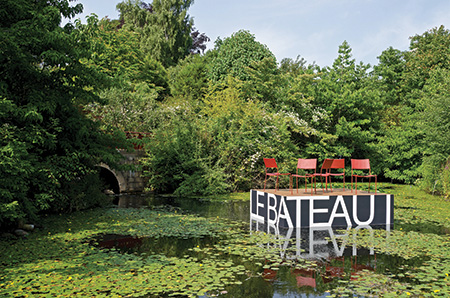Mostly West

Franz West made art as a form of relationship, a type of exchange, as a language used in a conversation betweenhim and the viewer or other artists. Westwas generally the instigator: sometimeshe would ask artists (including choreographers, musicians and writers) to ‘complete’ a work of his. Other times, pieces weresent back and forth in a lengthy exchange (such as the project piece with Anselm Reyle for the Schinkel Pavilion, Berlin, in 2012).
‘Mostly West’ was a large survey of these extensive collaborations – with the likes of Douglas Gordon, Sarah Lucas, Maria Faust and Michelangelo Pistoletto, to name afew (it included 28 collaborators in total) – curated by Ines Turian, West’s long-time studio manager and friend. West is what you could describe as an ‘artist’s artist’ – onewho was highly influential on his peers, from Heimo Zobernig to Mike Kelley, as wellas later generations of artists, and one whocollaborated frequently, with few limits on what might result. Many of the works in ‘Mostly West’ demonstrate how these exchanges manifested as ideas and materials, a form of conversation via sculpture, language, and bodies. Within them, however, each individual artist’s touch also remains distinct.
His earliest and life-long project, the Passstücke (Adaptives, which he began making in 1974) – plastered bandages sculpted into different forms, some more literal, such as a skirt, others abstractly lumpen – were made to be used by the ‘viewer’. Included here was Spiegel in Kabine mit Passtücken (Mirror in Cubicle with Adaptives, 1996), acollaboration with Pistoletto. A simple room built within the gallery was lined with newspapers of the day – here The Scotsman from the week Andy Murray won Wimbledon. Visitors were invited to ‘Take an adaptive and go into the cubicle’, inside of which was a mirror, positioned by Pistoletto, in which you could watch yourself in action. The ‘Adaptives’ are bumpy forms on the endof steel poles; as I picked one up tentatively, the gallery assistant informed me that these are updated after every exhibition,so there was no need to be too precious.
For West, the social situationbetween object and viewer was the art work. In an interview with the curator Tom Eccles, he once described this dynamic as ‘the capacity of art to be the meeting of object and event’. Chairs, divans, tablesand other furniture occurred regularly in his work – very often fabricated by specialists, such as the often repeated ‘Uncle Chair’ – quite literally allowing viewers to sit, rest, look and talk. A number of works in ‘Mostly West’ played with this domestic, relational aspect. One particularly humorous moment occurred when West collaborated with Marina Faust on Talk Without Words (Christopher Wool) (2012) – surely a wry take on Wool’s own ubiquitous word paintings. West made a lime-green table and chairs, to which Faust contributed a mohair ball ofthe same colour, hanging over the table as if a light fitting. It is, however, for people to sit down and head butt one another.
A beautiful, delicate pair of lilos-cum-chairs by West and Tamuna Sirbiladze (Canale Grande, 2010) sat in a room across from a trademark Sarah Lucas fried egg (Untitled – Not Finished, 2012) that lay on top of a rock-like papier-mâché sculpture by West, as if frying in the sun. As I contemplated the chairs, wondering whether to sit,I listened to a conversation two women were having about wanting to sit on these ‘amazing’ chairs themselves. The gallery assistant said she was sorry but that they couldnot be used. She directed them over to a low divan in the corner and suggested that they sit or lie on that to look at the painting overhead (Siesta, 2003, with Rudolf Polanszky). They lay down together and immediately smiled, as one exclaimed, ‘Oh I love that, it reminds me of peacock feathers.’ She was absolutely right. I was reminded of acomment that Lucas made when I recently interviewed her about her relationship to West: ‘Objects are symbols for people.’
West made art to keep us company. Part Pop, part amorphous abstraction, his public sculptures are brightly coloured intestinesor faeces slipped into the public realm – Trojan Horses in the guise of art. ‘Mostly West’ did not include any of these works, although Inverleith House has several displayed in the gardens, from a commission West undertook there in 2001. However, the highlight of the show was outdoors in the beautiful Chinese Hillside Pond: in the midst of hundreds of water-lilies floated a plinth-like raft (Bateau Imaginaire, Imaginary Boat, 2005, with Heimo Zobernig). On top of this sat four perky red chairs, as if beckoning visitors to swim over and clamber aboard. The director of Inverleith House, Paul Nesbitt, suggested a strangely apt art-historical lineage to me: from Claude Monet via Ian Hamilton Finlay to Franz West.
West died last year, so I will never get to meet him. But I will have a relationship with him every time I see his work, as he has left the conversation open. Indeed, Lucas recently noted that West was ‘less dead than anyone alive’.















